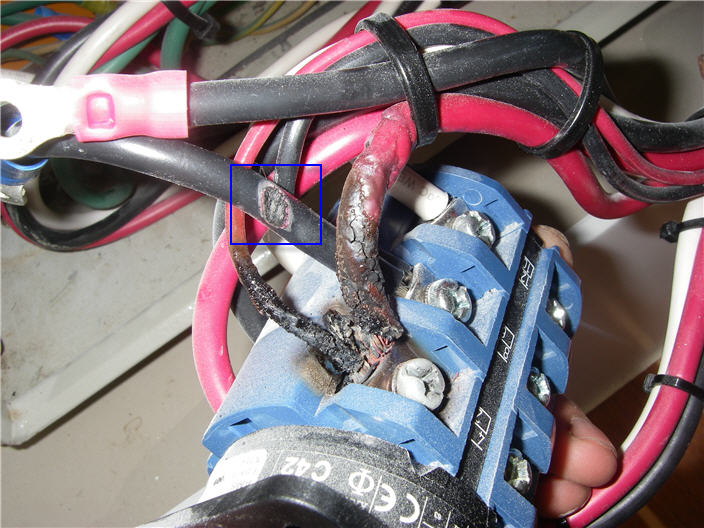Barnacles and crabs make strange noises at night. It sounds like someone is popping bubble wrap all night long next to my bed, which is smaller and harder than I’m used to, not to mention that I’m sleeping on the “wrong” side—opposite from the bed at home, where I have slept at Jay’s left side for nearly 11 years. Occasionally, Sam tumbles out of his bunk and I have to respond to cries of confusion if he wakes during the fall (sometimes he sleeps through it and we find him asleep on the cushion on the floor!). I have almost knocked myself unconscious numerous times in small passages in such middle-of-the-night maneuvers. Morning comes too soon. While cooking breakfast one morning, the power failed and I was left with soggy bacon and a bowl of pancake batter. Yum. When it rains, the “roof” leaks. Right over the beds, of course—where else? The afternoons are sweltering, and even with the (praise be to God!) air conditioning on, the salon is warm, the galley warmer. The fridge and freezer, combined, are smaller than my refrigerator space at home. The front burners on the aged stovetop don’t seem to operate at any other setting than “HIGH.” The head (strange name for a toilet, eh?) smells like rotting sea life and you have to manually pump sea water in and sewage out to a holding tank, which gets pumped out once a week. And even in our calm, sheltered marina on the Manatee River, the whole place is always moving.

I hope it doesn’t sound like I’m complaining. These are simply some of the things I’ve had to get used to as we have begun to spend weekends on the boat at the dock. Jay is currently repairing the port prop shaft (which connects the engine to the propeller), so we haven’t actually gone anywhere yet, but I am so grateful for this time to “practice” living aboard. We can learn the rules and routines in a relatively safe environment. We are close enough to home that we can bail if we need to, but also near local amenities like the marina swimming pool and the Bradenton Public Library so that there’s somewhere to go if we just want to get off the boat for short spells. We are attached to shore power and water, which means the comforts of unlimited (cold) showers and (mostly cold) air conditioning. It’s like learning to live aboard with training wheels—the change variables are blessedly limited. Even so, it takes some adjustment in outlook and attitude to get used to this new way of life.
This is the adventure we have craved, so we are joyfully learning to adapt to changing circumstances. There is no greater analogy to life than sailing—a vessel in a fluid environment with the wind constantly shifting, currents and tides, things you can’t see lurking beneath—the whole operation demands flexibility, vigilance and a good attitude, and not a little humility! I gave the children some peanut butter bread and went to the neighbor’s motor yacht to cook the pancakes on the fateful morning of the electrical meltdown. When it rains, we set out the pots and bowls and towels and try to keep the baby from rearranging our carefully devised drip-catching system. When it’s hot, we sweat like the human body was designed to do and drink water and stay in the shade and rest. I’m learning how to cook again with different pots and pans, different stove and oven, different ingredients because of limited refrigeration, and lack of gadgets. In essence, we’re learning that we really don’t need that much to be happy. I can even live without my (gasp!) precious Vita-Mix. We spent three nights aboard this past weekend, and by the third night, I fell asleep quickly and slept soundly (and so did Sam). As we get things organized and cleaned, it’s starting to feel like home. The children are learning to entertain themselves while we busy ourselves with projects, and to adapt without complaint. It’s not always smooth sailing (pardon the pun), but we’re getting there, little by little.
Then there are the beautiful things to get used to which I neglected to mention: falling asleep with a hatch open and a cool breeze blowing in and the moon and stars overhead. Waking up to bird calls. Breakfasting outdoors on the waterfront. Washing dishes with a 360˚ view—palm trees, the swaying masts of sailboats in the marina, the sunshine on the water, the clouds, the sky, the train bridge. Sea life at our doorstep: jellyfish, crabs, fish of all shapes and sizes—the kids spend hours in the cockpit looking over the coaming into the water. In the late afternoon, after the rain, a refreshing breeze blows. In the evening, we climb onto our “roof” and watch the red sun sink into the sea and light the clouds on fire. When the children are in bed, Jay and I get a cup of tea, or glass of wine, or cold beverage, as the mood strikes us, and sit up on deck, talking and laughing and listening to the live music from a nearby restaurant drifting over the water to us on our private, floating paradise.
We wonder what our parents will think when they come to visit us at our new home. Will they wonder what kind of man provides such a small, leaky, dirty, broken-down home for his family (in some places, the boat is literally held together by string and duct tape)? Or will they see it as I do: a perfectly simple, self-contained, cozy, exotic living space with an incredible view? I venture to say that some wives (including me just a few short years ago) would complain about the inconveniences which I am learning are part of the quirky charms of living aboard. Now when I hear people complain about not having enough space and needing to move to a bigger house, I laugh! What do we really need space for? We have four cabins with full beds and two quarter berths, so there’s room to spare. Since we spend all our time in the cabins unconscious, they don’t need to be big. Our salon is spacious enough, the table easily seating eight, with a separate sitting area and space for kids to play on the floor. The galley is adjacent, so when I am cooking or cleaning or baking (which is a lot of the time), I am a part of the action. The cockpit is enclosed, which makes it relatively safe, and seats six to eight. The deck is just enormous—open and uncluttered, wide and comfortable. And the yard—it never needs mowing!
It’s true that one’s outlook changes everything (call me Pollyanna). Learning to take every day as it comes is an art. Beginning to see all of life as an adventure is essential to a vibrant and passionate existence. Slowing down is good for us, and living simply, though it may actually entail harder work, is more rewarding than living an easy, convenient life. Certainly, this way of life is not for everyone, but everyone can benefit from the lessons it is teaching us.

